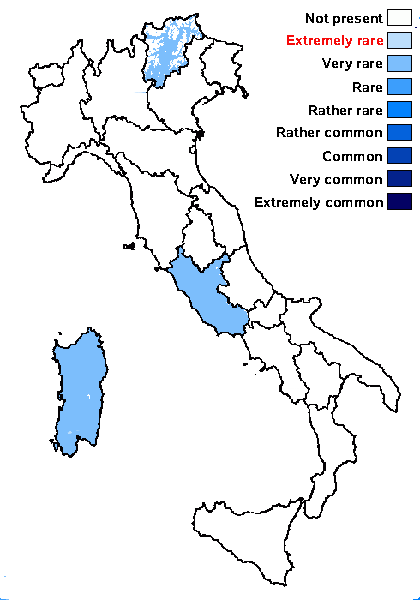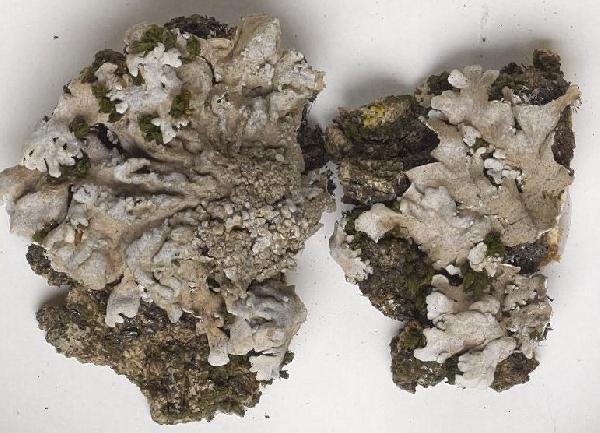Physconia thorstenii A. Crespo & Divakar
in Divakar & al., Mycol. Res., 111: 1315, 2007.
Synonyms:
Distribution: N - TAA (Divakar & al. 2007). C - Laz (Divakar & al. 2007), Sar (Divakar & al. 2007).
Description: Thallus foliose, heteromerous, dorsiventral, adnate, forming more or less orbicular, up to 6(-8) cm wide rosettes. Lobes linear, discrete to usually imbricate, 1-3 mm wide, flat to irregularly concave. Upper surface grey to grey-brown, uniformly or patchily and coasely white-pruinose, especially at lobe-tips, the margins often bearing up to 1 mm wide secondary lobules, most commonly in thallus centre. Lower surface tan to pale brown in the peripheral zone, dark brown to black in central parts, with black, squarrosely branched rhizines which may form a dense mat. Upper cortex prosoplectenchymatous in longitudinal section, but appearing paraplectenchymatous in transverse section, with thin-walled, rectangular cells, overlain by a 8-12 µm thick epinecral layer; medulla white; lower cortex prosoplectenchymatous. Apothecia common, lecanorine, sessile, 1-2 mm across, with a brown, often pruinose disc and a usually lobulate thalline margin. Epithecium brown; hymenium and hypothecium colourless; paraphyses slender, simple or forked in upper part, the apical cells clavate, with a thin, dark brown cap. Asci 8-spored, clavate, the K/I+ blue tholus penetrated by a faintly amyloid apical cushion with parallel or diverging flanks, the wall K/I-, surrounded by a K/I+ blue outer layer, Lecanora-type. Ascospores 1-septate, brown, ellipsoid, (24-)27-34(-40) x (12.5-)14.5-18 μm, with an ornamented perispore, thickened at septum but not at apices, Physconia-type. Photobiont chlorococcoid. Spot tests: cortex and medulla K-, C-, KC-, P-, UV-. Chemistry: without lichen substances,Note: this recently-described corticolous species grows on the nutrient-rich or moderately eutrophicated rough bark of a wide range of both deciduous and evergreen trees. Common in the central Iberian Peninsula, it is also known from the southern Euro-Asiatic region (Italy, Austria, France, Greece, Cyprus, Saudi Arabia, Afghanistan, Pakistan, Tadzhikistan), and from North Africa (Morocco). In Italy it might have been confused with P. distorta, and might be more frequent.
Growth form: Foliose, narrow lobed
Substrata: bark
Photobiont: green algae other than Trentepohlia
Reproductive strategy: mainly sexual
Commonnes-rarity: (info)
Alpine belt: absent
Subalpine belt: absent
Oromediterranean belt: absent
Montane belt: very rare
Submediterranean belt: very rare
Padanian area: absent
Humid submediterranean belt: very rare
Humid mediterranean belt: very rare
Dry mediterranean belt: very rare

Predictive model
Growth form: Foliose, narrow lobed
Substrata: bark
Photobiont: green algae other than Trentepohlia
Reproductive strategy: mainly sexual
Commonnes-rarity: (info)
Alpine belt: absent
Subalpine belt: absent
Oromediterranean belt: absent
Montane belt: very rare
Submediterranean belt: very rare
Padanian area: absent
Humid submediterranean belt: very rare
Humid mediterranean belt: very rare
Dry mediterranean belt: very rare

Predictive model
 INDEX FUNGORUM
INDEX FUNGORUM
 GBIF
GBIF
 DOLICHENS
DOLICHENS


